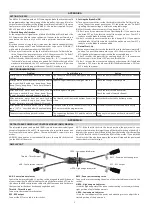
RAPID DESCENT TECHNIQUES
EN
11
10
Landing
The XXLite 2 shows no unusual landing characteristics but as a reminder, here are some tips:
• Always set up for your landing early, give yourself plenty of options and a safe margin for error.
• Once below 30 metres avoid turning tightly as the glider will have to dive to accelerate back to normal
flight. If you are at low altitude, or if you hit sink, this could mean you hit the ground harder than
necessary.
• Lean forward out of your harness before the actual landing (especially if it’s turbulent), with your weight
leaning forward against the chest strap, and make sure your legs are ready for the landing and a possible
PLF (parachute landing fall).
• Allow the glider to fly at hands up (trim) speed for your final descent until you are around 1 metre above
the ground (in windy or turbulent conditions you must fly the glider actively all the way). Apply the brakes
slowly and progressively to slow the glider down until groundspeed has been reduced to a minimum and
you are able to step onto the ground.
• In light winds/zero wind you need a strong, long and progressive flare to bleed off all your excess ground
speed. In strong winds your forward speed is already low so you are flaring only to soften the landing. A
strong flare may result in the glider climbing upwards and backwards quickly, leaving you in a vulnerable
position.
• If the glider does begin to climb, ease off the brakes (10-20cm) - do not put your hands up all the way -
then flare again, but more gently this time. Keep the brakes at mid speed, stand up, be ready to run and
make sure you brake fully as you arrive on the ground.
• Choose the appropriate approach style in function of the landing area and the conditions.
• In strong winds you need to turn towards the glider the second your feet touch the ground. Once facing
the wing pull smoothly and symmetrically down on the brakes to stall the wing. If the glider pulls you,
run toward it.
• If the wind is very strong, and you feel you might be dragged, or lifted again, stall the glider with the C
risers. This stalls the wing in a very quick and controllable way and will drag you less than if you use the
brakes.
• Always land heading into wind!
Ozone would like to remind you that the following manoeuvres should be learnt under the supervision of
a qualified instructor and always used with caution. Never forget that properly analysing the conditions
before launch will help avoid the need to use these techniques. Compared to a normal paraglider where
the ribs are protected within cell walls, the exposed nature of the XXLite 2’s make it more susceptible to
damage. Because of this we do not recommend you to perform SIV or aerobatic manoeuvres. Doing so
will reduce the lifespan of the wing and done incorrectly could result in damage to the wing.
Big Ears
Folding in the wingtips increases the sink rate without radically changing the airspeed. This is useful for
staying out of cloud or descending quickly through the lift band of the hill, for example when top landing.
To pull big ears, keep hold of your brake handles and take the outermost A-line on each side, then pull out
and down (preferably one at a time) until the wingtips fold under. The size of the big ears can be adjusted
by pulling more line, or reaching higher up the line. For directional control while using the Big Ears, you
should use weight shift. To reopen the ears, release both A lines at the same time. To help reinflation,
brake gently one side at a time until tips regain pressure. Avoid deep symmetric applications of the brake
as this could accidently induce parachutal or full stalls.
You may use Big ears for the final landing approach but they should be released before making the final
flare. Ozone advise to not use this technique in turbulent or windy conditions due to the reduced ability to
fly actively and the risk of an inadvertent stall whilst descending through the wind gradient.
Once the big ears are engaged you can further increase the sink rate by pushing on the accelerator bar,
however NEVER try to pull the Big Ears in if the accelerator is already pushed. The lower angle of attack
and the act of deflating the tips can lead to a major deflation. Always make the Big Ears first and then
apply the speed bar.
Whilst it is possible to enter a spiral dive whilst holding in Big Ears, the high forces applied to the lower
lines could exceed the breaking strain of the lines leading to equipment failure!
Ozone strongly recommend to NOT perform Spiral Dives with Big Ears engaged.
NEVER
induce Big
Ears in accelerated
flight, this can lead
to a major deflation.
Always pull the Big
Ears first and then
apply the speed bar.
DO NOT
perform spiral
dives with Big Ears
engaged.
Содержание XXLite 2
Страница 1: ...Pilots Manual...
Страница 2: ......
Страница 16: ...1258 Route de Grasse Le Bar sur Loup 06620 France...

































